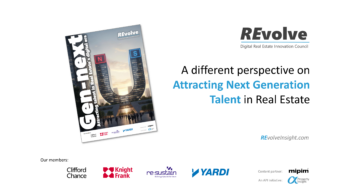Blockchain Technology Uses in the CRE Space Could Revolutionize the Industry in the Next Ten Years[1]
The blockchain (1) has been a topic of discussion for some years now, but 2018 appears to be the year that the discussion began to shift away from its narrow, oft-associated relationship with cryptocurrency toward a much broader scope of its uses across many industries, including commercial real estate. As we enter 2019, we can expect to see increased momentum behind the technology, from startups to some governmental entities already wagering that it will fundamentally change the way we all do business. Since many of us are still attempting to understand the concepts backing blockchain technology and what makes it so potentially impactful, it might help to imagine a real estate deal of the future and examine where we might see blockchain technologies play a role.
The Property Search
You, the reader, are at the center of this deal. The year is 2029. You’re in the market for a buy-and-hold opportunity with reliable annualized returns. To initiate your search, you’ve gone to your favorite software property listing DApp[2] From that platform, you’re able to search a wide spectrum of properties meeting your criteria and are presented with highly specific and reliable data. You hark nostalgically to 2019 when you had your start in the industry (Remember, we’re time traveling.), when listings were largely fragmented across multiple applications, siloed amongst various brokers networks, and required hefty subscription fees along with heavy research to make sense of all the fragmented data. Instead, the blockchain-enabled listing service allows trusted property data to be accessible on a peer-to-peer network.[3] As a result, you see property data during your initial search phase that previously wasn’t gained until detailed due diligence. The greater information transparency has made it less necessary for you to be physically located in the markets where you deal, and the tokenization of real estate assets has even made it easier to pursue cross-border transactions in foreign markets. It is also now easier to bite off exactly the capital allocation you wish to provide via a partial interest in some of the more stable properties. You succeed at identifying a suitable short list of properties in your target markets that appear to meet your investment objectives. The time-saved by eliminating non-contenders at this early phase is noteworthy in itself.
Underwriting and Financial Evaluation
Each candidate property you’ve identified has been assigned a unique digital identification (ID) attached to the property’s history (financial, legal, environmental, etc.). You pause to reflect on how property DApps gained favorability for doing transactions over the years, incentivizing property owners and brokers to register a global and unique digital ID so a property could be exchanged via this method. With a digital ID created, virtually anything that has happened to a property is timestamped and recorded as a secure, immutable block on the chain.[4] You are thus able to access rent rolls, tenant profiles, occupancy records, expenses, maintenance history, and virtually anything else you need to produce an informed bid price for those properties in which you have interest.
Since you’ve become pretty good at this, you manage to complete this task in one sitting at your computer. What once took you a matter of days or weeks contacting people and gathering necessary documents (all while constantly questioning their validity) can be completed in half a day. You do occasionally lament for the old days, however, back when some dogged detective work and a little skill differential might translate to a negotiating advantage. With all this newfound transparency, the bid/ask margins have narrowed considerably, which is good for increasing liquidity in real estate assets, but has definitely removed some of the ‘art’ from the deal. And while the time-savings can be nice, the relative ease of the process has made buyer competition much fiercer, although less dispersed. In your case, you find that all but one of your final contending properties have already been put under contract, despite your lightening quick analysis.
Due Diligence
With the target property in mind, you register your interest to the seller’s broker directly through the same DApp that you’ve been using for the property search. You also appoint your lender through the DApp, to begin the loan approval process, should all parties agree. You next contact a partner that is located near the subject property that can facilitate and spearhead the physical inspections. The physical inspections should be the longest portion of due diligence, by far, since they still require old-fashioned boots on the ground. However, much has changed with the process of title verification, which used to be (back in 2019) a very tedious legal effort, often necessitating title insurance policies. But now, title history and owner verification are achieved instantly through the blockchain-enabled DApp. Premiums have subsequently been slashed or eliminated, reducing a significant traditional transaction cost.
Through your own personal digital ID, your lender is also simultaneously, and near instantaneously, able to conduct its own due diligence of you as the prospective mortgagor by examining your financial records, personal history and track record. No need to scan and upload all of those income statements and other personal financial documents. It’s all on a (different) blockchain and accessible to the lender with the required authorizations. Of course, the lender performs its own independent underwriting, title verification, and computer automated property appraisal, as well. The information reliability and transparency on both the property and the borrower (you) results in a low-risk profile relative to traditional methods the lender would have relied upon in the past. Your lender fees are consequently lower due to the reduced administrative processing and specialized training required to approve your loan and close on the property.
(Smart) Contract Signing
Again, through use of the same secure online DApp, you and the seller have selected all the terms for the purchase agreement and provided your secure digital signatures. Your earnest money deposit was instantly verified on the blockchain and transferred from your designated account into an escrow (no need to wire money or wait for funds to clear the old-fashioned way). As conditions are met, automated tasks are performed to further the sale towards closing.
Separately, another smart contract is initiated between you and your lender that is linked to the contract ID for the subject property that sets the terms of the mortgage (interest rates, payment period, schedule of payment withdrawals, etc.).
Closing the Deal
Final terms of the contract have been met. Your down-payment is instantly withdrawn from your account. Closing costs and commissions are simultaneously paid by the lender directly to the designated third parties. Net sale proceeds are then transferred to the seller. This exchange of funds happens with the mere click of a button. The advanced automation combined with implementation of trusted transactions has eliminated many of the traditional escrow and closing costs that you once remembered as a high cost of doing business in real estate. The time-savings have been condensed to roughly as long as it takes to conduct the required physical inspections of the property (unless a longer time period is specified in the contract).
Next, an automated notice of sale is forwarded to the registrar where a new transfer title will be initiated and converted into a new permanent and immutable block on the blockchain.
The closing also initiates the contract maintained with your lender, beginning automated debt servicing according to the contracted re-payment schedule.
Overall, the lower transaction fees allow you to buy and sell property more quickly than before and so property turnover has generally increased as portfolios constantly tweak what they want to buy, hold or sell. Brokers make less money per deal now, but do far more deals.
Lease-Up
With the acquisition phase complete and the property now ready for lease-up, you return to the DApp once again, where your broker uploads the property ID, marketing it to potential tenants. Through a similar due diligence process as described above, you are able to research interested tenants, while potential tenants are able to research the subject property and its owner(s). As tenants are vetted and selected, a smart contract is initiated that identifies the lessor (you) and lessee(s). Any deposits and/or rent concessions are automatically transferred between parties and the right of possession is transferred to the lessee(s). (And another block is thus recorded on the chain.)
Cash Flow Management
The smart contract performs the scheduled rent payments per the agreed terms. Since you negotiated a net lease, expense reimbursements are also automatically withdrawn from tenant accounts. Likewise, your contracted expenses are automatically transferred to appropriate third-party contractors and recorded as cash outflows. Whenever a lease term is completed, any deposits will be automatically returned to the lessee(s).
Real-Time Data Analysis / Asset Management
For their part, your tenants appreciate the ability to verify your expenditures as they are recorded on the blockchain to assess how well their reimbursements are being utilized. You’ve made this approach to transparency a key component of your strategy for maintaining long-term tenants, along with great holiday parties and occasional tenant team bowling leagues, as you rise above your local competition that has remained resistant to blockchain technology.
You’ve also invested in advanced software and a host of sensors throughout the property that merges Internet of Things (IoT) technology with your blockchain-enabled smart contract. When sensors detect maintenance deficiencies, work-orders are immediately submitted to the appropriate contractors, and payments are automatically made after the work is performed. This upfront capital investment to automate many maintenance tasks is costly, but you predict it will greatly reduce any large, unplanned capital expenditures down the road.
The open, distributed ledger you maintain on the blockchain for all of these related transactions provides a reliable audit trail and aids your decision-making by helping you (and your property manager) identify where operating efficiencies can be created that increase net cash flows and property valuation. Every action taken is permanently added to the property’s digital performance record. This transparency of data adds to your investors’ confidence, which you hope to be a benefit on your next, bigger deal. And you hope it will enhance your negotiating position with future buyers, as your assigned valuation should be less disputable.
So, How Will We Get There from Here?
If you don’t currently have a firm grasp on blockchain technology, hopefully this brief scenario succeeded in giving you some practical insight to how it could be impactful to the real estate industry. Like you learned to use the internet without fully understanding how it worked, it’s likely that blockchain technology will continue to develop under your nose without you realizing it until one day, not too long from now, you are substantially reliant on decentralized applications to advance your professional and personal life.
There are many obstacles to blockchain implementation, more than are described here. The tedious task of transferring data from centralized databases (or paper records) to the blockchain is one issue at the forefront, as well as transferring it in sufficient scale to promote user-generated momentum for further growth.
Propy is one property DApp with a vision to create a comprehensive online transaction platform, similar to what’s described in the above scenario, and which would seek to make trading real property nearly as effortless as trading stocks on an online exchange. Their white paper acknowledges that blockchain is still an immature technology that will require multi-stage implementation and realistic growth milestones before it comes close to reaching its full potential.[5] Propy and other experts suggest that the area most ripe in the real estate industry for initial implementation is the transfer of property titles to decentralized land registries. Several countries, including Brazil, Russia, India, Sweden, Ukraine, UK, and Japan, are leaders already taking concrete steps toward this goal.[6][7]
Entering 2019, it may be wise to start following the successes and setbacks that these leaders face in order to gauge the future pace of blockchain growth in the real estate sector. 57.9% of respondents in a 2015 World Economic Forum survey of 800 executives and information and communications technology experts believe that 10 percent of the global GDP information will be stored on blockchain technology by 2025.[8] So, it is somewhat likely that at least a few components of the scenario highlighted in this discussion could come to fruition.
Blockchain will be discussed at MIPIM PropTech Europe 2019!
Click to learn more about MIPIM PropTech!
References
[1] The primary source and inspiration for this article is taken from: Deloitte Center for Financial Services (2017). Blockchain in commercial real estate: The future is here; How blockchain-based smart contracts could revolutionize commercial real estate. Retrieved from: https://www2.deloitte.com/us/en/pages/financial-services/articles/blockchain-in-commercial-real-estate.html#
[2] ‘DApp’ is an accepted abbreviation for Decentralized Application. Similar to how standard ‘Apps’ today facilitate uses of the internet, DApps are the gateway for end-users to interact with the decentralized online databases (back-end) that are the foundation for blockchain technology (without having to understand the technicalities that make it work).
[3] Brokers can be incentivized to upload listings to the platform in exchange for tokens native to that blockchain. Tokens are the fuel required to power any blockchain, rewarding individuals for providing the computing power required to run the distributed network, and acting as a form of currency within the community of blockchain users.
[4] Data is considered tamper-proof (and therefore, trusted) because every node on the distributed network maintains a copy of the distributed ledger; any attempt to alter a single node would be reported by the other nodes of the network. Data integrity, however, remains a limitation since all data initially entered about a property is only as good as the person that enters it. Certain system checks and incentives would be necessary to ensure data integrity from those inputting the data (brokers, owners, property managers, etc.). Peer-reviewed digital ‘reputations’ are evident in many online applications and could be a model for possible use in property DApps, as well.
[5] Propy. (June 29, 2017) PROPY — Global Property Store DApp is here to revolutionize the real estate industry. Retrieved from: https://blog.propy.com/propy-global-property-store-dapp-is-here-to-revolutionize-the-real-estate-industry-ff5e74ceed1f
[6] Miller, Charles H. (November 7, 2017) Blockchain Land Records: 6 Countries That Are Testing the Technology As We Speak. Retrieved from: https://www.walletweekly.com/blockchain-land-records/
[7] Iesho, Ashour. (2017, June 27th) Japan to Trial Blockchain for Real Estate Records. Retrieved from https://bitcoinist.com
[8] “Deep Shift: Technology Tipping Points and Societal Impact,” Global Agenda Council on the Future of Software and Society, World Economic Forum, September 2015.




